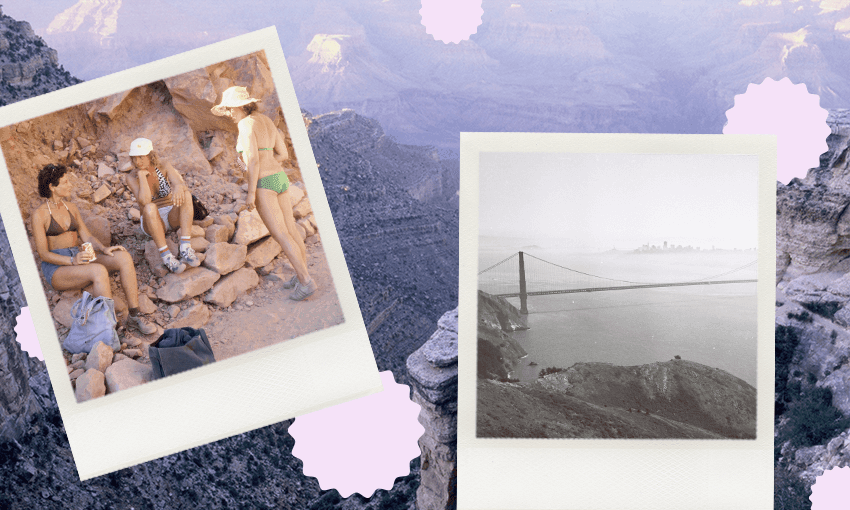An extract from the chapter ‘San Francisco’ in Travelling Light, a travel memoir by Canterbury-based Steve Lowndes with photography by Lisa Potts.
We found Luise in her ground-floor flat half a block from Mission Street and after an evening spent talking and drinking on her back stoop we set about finding somewhere to live and somewhere to work. Like New York, San Francisco was a patchwork of neighbourhoods defined by wealth, ethnicity and colour and they were all pressed together at the end of the hilly peninsula that the city was built on. Chinatown was like a town within a town, to the north was Japan Town and Russian Hill. To the south was Little Italy where Italians, Greeks and Turks ran small businesses and then the Mission, where Spanish was the lingua franca. To the west were the districts Castro and Haight-Ashbury and to the east, over the Bay Bridge, was Oakland, the predominantly black area where I was to spend many days.
San Franciscans saw themselves defined by at least two powerful concepts. One was that if you picked up the USA and shook it, everything and everybody loose would end up in the Bay Area and secondly, they saw themselves as being on the ‘inside’ and everybody else was without. People seemed to seriously believe that what happened there would happen to the rest of the world tomorrow, and as a consequence of this they spent an awful lot of time worrying about what they were doing and how they felt about it.
After a false start working all hours for a pittance at a pancake shop, Robyn found a comfortable room and a job she could enjoy at Caffè Trieste, one of the early citadels of the Beat movement. The ghosts of Allen Ginsberg, Richard Brautigan and Jack Kerouac still clung to the walls and the poet Lawrence Ferlinghetti, whose famous bookshop The City Lights was just around the corner, took his coffee there. On Saturday mornings there would invariably be an impromptu music session and well-known arias were belted out by enthusiastic locals, often accompanied by Robyn on the mandolin. The cafés and clubs on Vallejo, Columbus and Broadway became habitual weekend haunts for us all and any excesses were soaked away in a bath house on languid Sunday afternoons.
Lisa went through the familiar indignity of induction into a secretarial agency; this one was called Office Overload and she immediately landed a job at the Hyatt Regency, an upscale hotel in the Embarcadero district downtown. For her this was the beginning of a series of jobs for different agencies all over the city and she made some good friends along the way.
We found an apartment at 1739 Pine Street which was just a block off Van Ness and a couple away from Polk Street, one of the busiest gay streets in the city. Polk was full of bars, hairdressers and shops for the lesbian, gay, bisexual and transgender community. You could even buy half-gallon tubs of lube. All the streets around were steep and there was a city ordinance that required you to park your car with the front wheels turned into the curb to prevent runaways. Open-sided cable cars rattled and screeched up and down the hills, pulled and restrained by cables built into the road and operated by skilled brakemen.
The apartment was in an old wooden building which had survived the earthquake of 1906 and it was on a lower ground floor, cosy and private. As soon as we were comfortably installed we acquired a telephone with bewildering simplicity. We went to a sales office and put down a $25 deposit on a telephone kit and walked home with it in a brown paper carrier. When we got to the apartment we simply plugged it in and a few hours later it was working. The rent, all local calls included, was $6 a month.
The agent for the apartment and many others was a red-haired Englishman called Justin and he hired me to paint the apartments he oversaw every time a tenant departed. It turned out to be a lucrative contract and I was soon driving over the Bay Bridge to renovate apartments in blocks all over Oakland. I set off with a bunch of keys, five-gallon drums of paint, drop cloths and a huge roller and I would lock myself into the apartment, strip down and paint like mad. In the end I could paint a two-bedroomed apartment in about four hours. All the tenants were African Americans and when they saw me in the elevator or in the hallways they looked right through me as if I wasn’t there. In Oakland the tables were turned and I was in the minority.
San Francisco as a whole was home to many minorities and while each had a place in the kaleidoscope of the city in the late Seventies, the gay community was one of the most visible. These were the years before the AIDS epidemic struck and there was a freedom of expression that knew no bounds. The district of Castro elected Harvey Milk, the state’s first openly gay politician, to public office in 1977. Harvey, along with the mayor, George Moscone, was tragically assassinated on 27 November 1978 by a disgruntled city supervisor. Immediately after the shooting a spontaneous march of 40,000 people took place to mourn their deaths. The next day shops and businesses were closed and the city was covered in memorial posters. Gay people had come to San Francisco from all over the States to avoid discrimination and prejudice and these assassinations struck deep into the core of these new-found freedoms.
To escape the trauma the city was going through we went up to Lake Tahoe and stayed in a holiday home belonging to one of Luise’s friends. She and Lisa went off cross-country skiing while Robyn and I stuck to the nursery slopes. This was a very different skiing environment to the European resorts we were more familiar with. There were no intimate villages with gemütlich coffee shops or après ski bars and restaurants purveying glühwein or venison. Ski chalets were carefully sited so that a smudge of blue wood-smoke among the dark pine trees was the only clue to their existence. A car was needed to get to the innumerable ski lifts which were scattered over a huge area and at dusk there was a veritable traffic jam as bright blue, yellow and red skiers headed home from the slopes. At Squaw Valley, site of the 1960 Olympics, the runs were carefully organised and skiing was a competitive and serious sport. Inconvenient effort had been eradicated and hiring gear and buying a day pass on the lifts did not cost an arm and a leg. The dress styles on the slopes were outrageous but then, as usual, the idea was to do your own thing rather than to dress for the activity.
Someone skied past in stretch pants and a Hawaiian shirt and somebody else in shorts and a tee shirt. One man gave his girl a piggyback ride down the mountain while an older man passed by drinking beer from a can and listening to a tape cassette plugged into his ears. At one of the ski lifts a group of young men leant nonchalantly on their poles. They wore headbands to keep their long blond hair out of their eyes, wraparound sunglasses and matching quilted vests and trousers in the latest style. I commented to Luise that they looked as if they were really good at skiing and she glanced in their direction and commented laconically, “Yes, and that’s probably all they are good at,” and continued to snap on her skis.
From high up on the crest of the Sierra the view was spectacular. To the east it was all brown desert spreading slowly and lazily into a very distant horizon. Below you could see the flat white bottom of the Squaw Valley with the line of a river wriggling across it like the joint in your cranium. All around there were rocky slopes studded with pine trees and snow fields dotted with moguls. Far below, Lake Tahoe was spread out like a vast blue ink blot on a white tablecloth.
I was sitting in the corner of a restaurant at the head of the main ski lift while the others had gone off down the mountain when I began to notice the weather outside had changed. An electrical storm had blown in and an announcement was made that the lifts were closing. This sent a ripple of excitement through those remaining at the terminus and when snow began to pile up on the steamy veranda windows, flashing looks of concern flickered around the bar. One by one drinks were tossed back and skiers departed with dogged determination until the only ones left were the employees, two people on crutches and me. As the light began to fade and it became obvious that the storm was settling in, they decided to activate the gondola for one last lift to the bottom. The gondola was a mini cable car and the cabins resembled a sedan chair without its poles or a Citroën Deux Chevaux minus its wheels and as I climbed in the guard advised me to sit in the middle where I would be better insulated if struck by lightning.
The car was capable of seating four people but I was the only one in it. The snow battered on the windows and the wind swung the car from side to side. Every now and then through the white-out I glimpsed a rocky outcrop or the top of a fir tree as it passed below, bent like a bow against the blizzard. When the car passed over a stanchion the sudden noise and vibration were startling and as the pressure changed it pressed on my eardrums. There were flickers of lightning and the deep roll of thunder and then the gondola came to a halt. I looked in every direction and there was nothing to be seen except whirling clouds of snow above, below and to either side. Just as I began to feel the cold searching for my bones the lift came back to life and two hours later it descended safely and gently to the terminus. Stepping onto terra firma had rarely felt so good.
Travelling Light by Steve Lowndes with photography by Lisa Potts (Quentin Wilson Publishing, $49.99) can be purchased from Unity Books Wellington or Unity Books Auckland.



